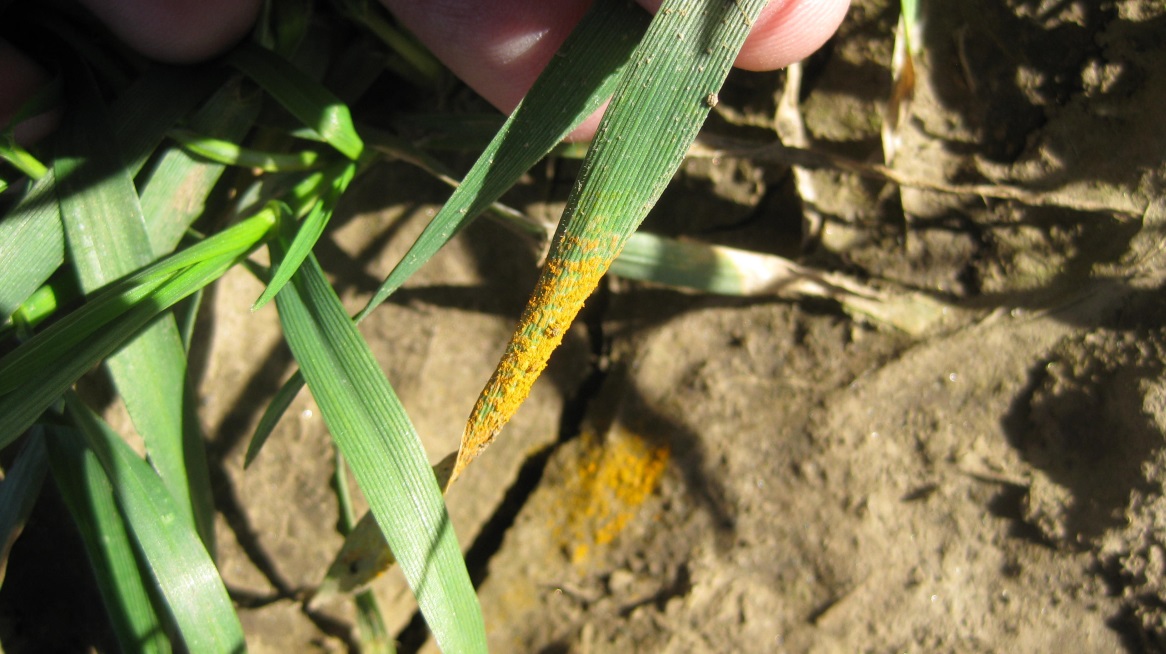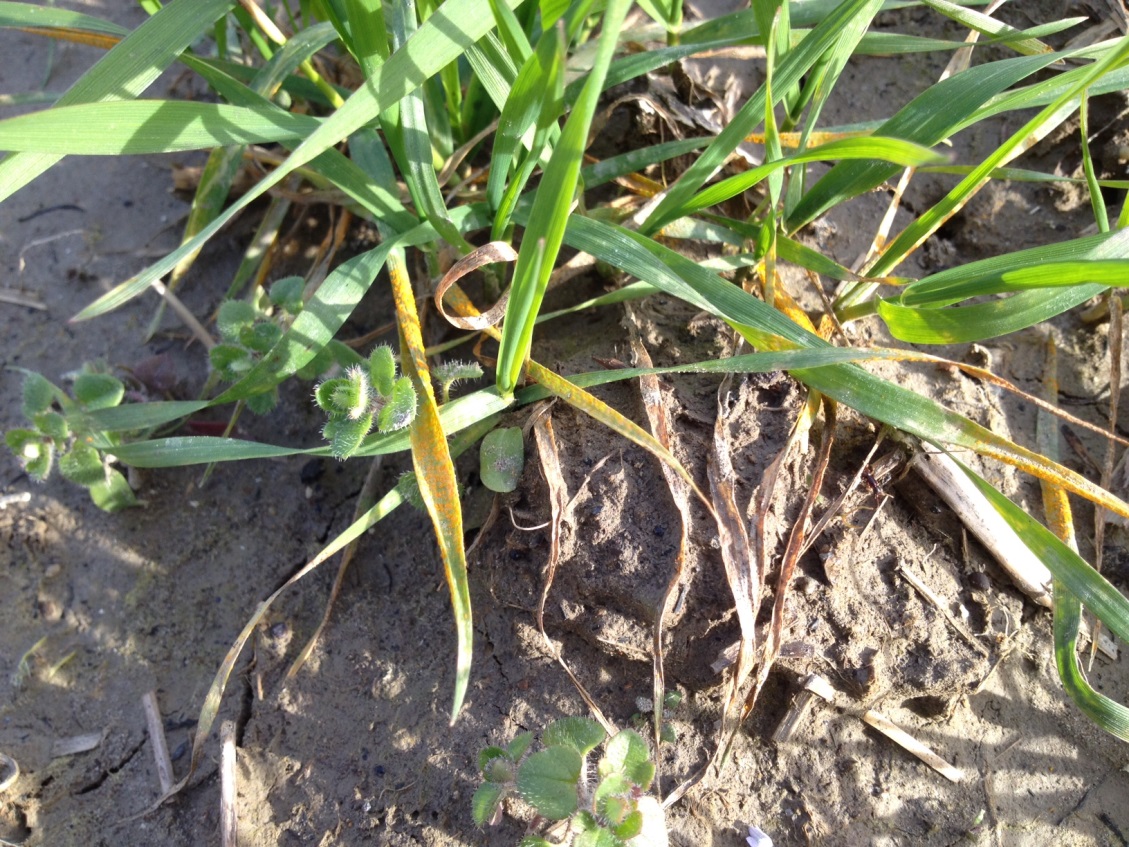Xianming Chen
Stripe rust forecast for the eastern Pacific Northwest
Based on our forecast models using the weather conditions from November 2014 to February 2015, stripe rust will be likely severe (40-60% yield loss on susceptible varieties) in 2015. The models resulted in an average yield loss of 60% with a standard deviation of 31% on highly susceptible varieties. This value, more than the 38% forecast made in January based on the November-December weather conditions, is similar to the yield losses of highly susceptible varieties observed in 2010.
Stripe rust found in Walla Walla, WA
On Mar 4, we were checking wheat fields in Whitman, Walla Walla, Benton, Franklin, and Adams counties in Washington, winter wheat plants ranged from tillering (Feekes 2) to early jointing (Feekes 5). Differences were observed in crop uniformity resulted from the soil moisture conditions in the last fall, from poor (not uniform) to good (uniform). Many fields in the Horse Heaven Hills region (Benton Co.), Franklin and Adams counties were planted twice, resulting in different stages of plants in the fields. No stripe rust was found in any of the commercial fields checked. Dead low leaves of big plants in fields in Benton, Franklin, and Adams counties, which likely caused by the unusually early cold period in the second week of November, should eliminate rust fungus, if any infection occurred last fall. Thus, rust fungus has unlikely survived in these fields.
However, we found stripe rust on susceptible varieties in our experimental wheat field near Walla Walla, which was planted on October 6, 2014. The plants were at Feekes 4-5 with the first and second leaves still alive, and rust was on low leaves actively producing spores (Fig. 1). The observation of several leaves with rust spores in the Walla Walla area is relatively early. For comparison, the first observation of stripe rust in the same location (only one leaf) was on April 23 in 2014, March 7 (heavier infection) in 2013, April 24 (only one leaf) in 2012, February 18 (heavier infection) in 2011, April 29 (similar level of incidence) in 2010. The average temperatures of 19-22oF (-6 to 7oC) and low temperatures of 14-18oF (-8 to -10oC) during the cold period of November 12-19, 2014 did not kill stripe rust fungus.
Fig. 1. Several leaves producing stripe rust spores found on susceptible varieties in an experimental field near Walla Walla on March 4, 2015.
Stripe rust in western Pacific Northwest
Stripe rust was first reported this year by Chris Mundt in Corvallis of western Oregon on January 10 in an experimental nursery planted on September 16, 2014. Mike Flower and others observed stripe rust in both experimental and commercial fields in middle January. The first observation of stripe rust in in the southern Willamette Valley was about three weeks earlier than previously record, according to Mike’s report.
As expected, severe stripe rust was observed today (March 5) by Kent Evans of our program in our experimental field near Mt Vernon in western Washington. The plot was planted unusually late (in the last week of November) due to heavy rain in October and the usually cold period with soil-freezing temperatures in the second week of November. Despite the later planting, stripe rust has developed to the normal level. About 20-30% rust severity was observed on almost all plants of the susceptible check variety (Fig. 2)
Fig. 2. Stripe rust on a susceptible check variety in an experimental field at Mt Vernon, WA on March 5, 2015. (Photo of Kent Evans)
Recommendations for the Pacific Northwest
Unlike the last year, as stripe rust is predicted to be severe and has been observed in the eastern Pacific Northwest, attention should be paid for control of stripe rust this year. The following lists some general recommendations for the eastern Pacific Northwest:
- Consider planting resistant spring wheat varieties and avoid susceptible ones. Use the Seed Buyers Guide to choose varieties rated 1 to 4 for stripe rust and avoid those rated 5 or above if possible. If a moderately susceptible or susceptible variety is planted, consider use fungicide at the time of herbicide application if rust can be found in the field.
- For the Walla Walla area and other areas in southern Washington, southern Idaho, and eastern Oregon, start checking your winter wheat fields. If stripe rust can be found and if the variety is moderately susceptible or susceptible (rate 5 or higher), use fungicide when apply herbicide. For areas further north in Washington and Idaho, start checking winter wheat fields about three to four weeks from now and consider use fungicide at the time of herbicide application if stripe rust is found or a moderately susceptible/susceptible variety is grown. Whether a second application is needed or not depending upon rust situation in the field and in the surrounding areas before heading.
- For western Oregon, Mike Flower, Chris Mundt, and others have already made recommendations for scouting rust and applying fungicide when needed. For western Washington, as usual, fungicide application is always needed at the time of herbicide application if the field is not planted with a resistant variety.
Stripe rust in other states
In addition to Oregon and Washington, stripe rust has been reported this year so far in Texas, Louisiana, Arkansas, Mississippi, and Oklahoma. Stripe rust was first found in northern Louisiana on January 22 and also found in central Louisiana in late January. Stripe rust was reported in northeastern Texas on January 29, in southeastern Arkansas on February 1, in western Mississippi on February 21, and southwestern Oklahoma on February 27. So far, stripe rust has been reported widespread in these southcentral states.
Compared to the past, the first observations in the southern Great Plains are relatively early. The earliest record of finding stripe rust in the region was January 8, 2005 in Texas, the year of a severe epidemic across from the south to the north and to the east. In 2010, another widespread severe stripe rust epidemic throughout the regions east of the Rocky Mountains, stripe rust was observed on February 20, but was indicated starting weeks earlier. In general, if stripe rust starts developing before March in the southcentral states, an epidemic will likely occur in the entire Great Plains. Therefore, it will likely be a big stripe rust epidemic year in the Great Plains and further east. As already recommended by cereal scientists in the above states, fungicide application is needed for fields planted with susceptible varieties. Growers in states to the west, north, and east should start checking fields according to the weather conditions and crop stages in your area, and consider using fungicide when stripe rust is seen.
Stripe rust was commonly found on in wheat fields in Montana and Wyoming in the last November. If temperatures went below 5oF (-15oC) without snow cover, rust is likely dead. For areas with stripe rust before the winter and temperature has been above 5oF, or below but with good snow cover, stripe rust fungus has likely survived in leaf tissue. Early scouting fields and fungicide application are recommended in these areas and surrounding regions.

